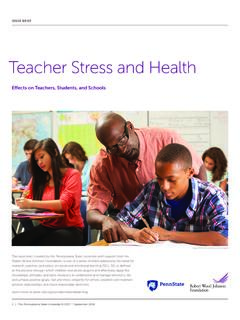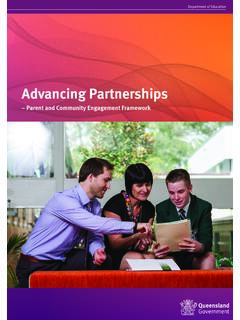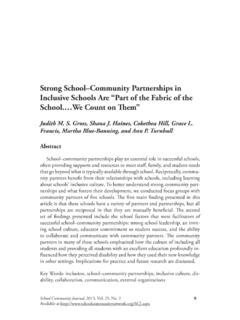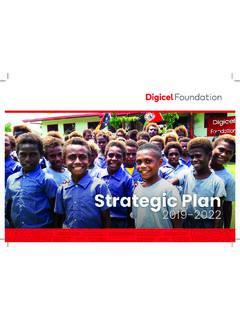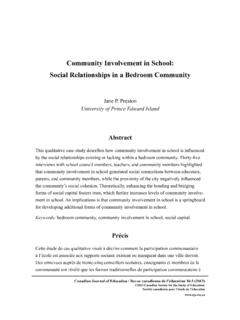Transcription of Promoting Social and Emotional Learning in the Middle …
1 Issue brief < strong >Promotingstrong > < strong >Socialstrong > and < strong >Emotionalstrong > < strong >Learningstrong > in the < strong >Middlestrong > and High < strong >schoolstrong > Years This issue brief, created by The Pennsylvania State University with support from the Robert Wood Johnson Foundation, is one of a series of briefs that addresses the need for research, practice and policy on < strong >Socialstrong > and < strong >Emotionalstrong > < strong >Learningstrong > (SEL). SEL is defined as the process through which children and adults acquire and effectively apply the knowledge, attitudes, and skills necessary to understand and manage emotions, set and achieve positive goals, feel and show empathy for others, establish and maintain positive relationships, and make responsible decisions.
2 Learn more at 1 | The Pennsylvania State University 2017 | October 2017. issue brief Executive Summary Adolescence is a critical period to invest in young people's < strong >Socialstrong > - < strong >Emotionalstrong > competence (SEC). SEC is essential for youth to succeed in < strong >schoolstrong > , work, and civic life, so supporting its development is an important component of a public health approach to education. This brief provides an overview of frameworks that define SEC, and reviews the current landscape of universal < strong >schoolstrong > -based programs designed to promote its growth in < strong >Middlestrong > and high < strong >schoolstrong > students.
3 < strong >Socialstrong > and < strong >Emotionalstrong > < strong >Learningstrong > (SEL) programs in secondary schools use various strategies to promote SEC through healthy youth-adult and peer relations, curricula, and structural adaptations. SEL programs can be organized into four categories based on their primary approach to fostering SEC: skill-focused promotion, academic integration, teaching practices, and organizational reform. SEL programs aimed at adolescents have received both less attention and less extensive research than those focused on the elementary years.
4 The research that does exist indicates that the effects of SEL on adolescent development appear to be important, but somewhat smaller than those of programs for younger children. This suggests that there may be ways to innovate to improve outcomes for youth. To do so, SEL programs should leverage the unique developmental needs of young people during adolescence, including their search for purpose and identity, the importance of peer relations, their attitudes towards themselves and others, and their meta-cognitive abilities.
5 Program developers should also consider the biology and < strong >Socialstrong > dynamics of adolescents as they develop the content and structure of programs. Research on the effects of SEL strategies is promising, but more support is needed to create long-term research-practice partnerships, and more rigorous research to expand the number of effective SEL programs that are available at the secondary level. Additional research also is needed to validate SEC frameworks in adolescence and to identify the most effective ways to support SEL systematically in secondary schools.
6 2 | The Pennsylvania State University 2017 | October 2017. issue brief Introduction This brief reviews the current knowledge of < strong >schoolstrong > -based programs designed to promote adolescent < strong >Socialstrong > - < strong >Emotionalstrong > competence (SEC). SEC is reflected in the knowledge, skills, and attitudes that young people need to manage thoughts and emotions constructively, regulate their actions, nurture a strong sense of personal and cultural identity, collaborate and resolve interpersonal conflicts, and cultivate healthy ,2 Research in adolescence has shown the fundamental importance of SEC in < strong >Promotingstrong > < strong >schoolstrong > engagement, post-secondary completion.
7 And workplace Secondary schools have an opportunity to positively influence adolescent development if they actively engage in < strong >Promotingstrong > SEC. < strong >Socialstrong > - < strong >Emotionalstrong > < strong >Learningstrong > (SEL) describes the process through which SEC develops. SEL. programs use a range of strategies to achieve this goal but most are built around the core belief that SEC grows out of positive youth-adult and peer-to-peer In this The rapid physical, brief, we describe and give examples of four categories of SEL programs. We also provide < strong >Emotionalstrong > , and an overview of the common strategies used across programs to promote SEC.
8 Cognitive changes that characterize In the United States, the introduction of SEL in education has primarily taken root in this period provide elementary schools. Yet adolescence is an equally critical period to invest in young unique opportunities people's SEC. The rapid physical, < strong >Emotionalstrong > , and cognitive changes that characterize this period provide unique opportunities to develop and practice During adolescence, to develop and young people begin articulating their beliefs and values, experimenting with new interests, practice SEC.
9 And expanding their < strong >Socialstrong > relationships. At the same time, enhanced cognitive abilities allow them to reflect on themselves and others more deeply, engage in more complex decision-making, and critically analyze the impact of their In adolescence youth also experiment with risky behaviors and face new challenges, including peer pressure, the negative influence of < strong >Socialstrong > media, and increased academic pressure, which present substantial challenges as well as opportunities for There are substantial contextual challenges to integrating SEL programming into secondary schools: Students make multiple classroom moves throughout the day, there is greater curricular variation, increased academic focus, and limited time for non-academic.
10 Programming. To redress these issues, SEL programs for secondary students often leverage system-level strategies aimed at creating a positive classroom and < strong >schoolstrong > climate that supports SEC as well as more direct student-level strategies to promote specific attitudes and These efforts also are of interest to educators and policy makers as they build inclusive environments free from hate and bias, thereby < strong >Promotingstrong > equity and reducing disparities for students of 3 | The Pennsylvania State University 2017 | October 2017. issue brief The Collaborative for Academic, < strong >Socialstrong > , and < strong >Emotionalstrong > < strong >Learningstrong > (CASEL).



